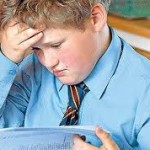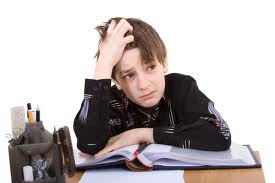A learning disorder or disability in children directly affects any level of intelligence. These children have a problem in receiving, processing, and/or expressing information. Because of this, the basic skills in reading, speaking, writing, listening, comprehension, or math are much affected. Learning disorder is passed down to the next generation. It is a condition that a child does not outgrow. If the parents give proper support, children with learning disorders may grow to become very successful.
It would really help a lot if you know what characteristics to look for in your child that indicate that he or she has a learning disorder. You should talk to the teachers or school staff to know what really happens during learning activities. In pre-school, the child has difficulty in learning if the child has difficulty speaking the right word; if the child cannot follow directions; if the child is very distracted or restless; if the child has trouble rhyming; and if the child has a hard time learning about numbers, shapes, colors, and days of the week. In the year that follow pre-school until the fourth grade, there is learning disorder is the child has trouble with language, reading, and comprehension; if the child has difficulty in planning; and if the child has a hard time remembering the proper sequences. The child has learning disability from 5th to 8th grade, if writing and reading activities are avoided; if there is difficulty in spelling, language, comprehension, and reading aloud; if work is slow; and if directions are misread.
Here is a list of learning disorders in children that you may want to discuss with your child’s doctor:
 1. Dysgraphia
 Dysgraphia is included in the list of learning disorders in children. This is a condition where the person’s ability to write is affected. There may b something wrong with the hand’s fine motor control or even processing the information. Occupational therapy is said to help those with dysgraphia. But if the patient doesn’t respond to this help option, he or she could just resort to using verbal communication, computers, or typewriters.
Dysgraphia is included in the list of learning disorders in children. This is a condition where the person’s ability to write is affected. There may b something wrong with the hand’s fine motor control or even processing the information. Occupational therapy is said to help those with dysgraphia. But if the patient doesn’t respond to this help option, he or she could just resort to using verbal communication, computers, or typewriters.
2. Dyslexia
 Dyslexia is in the list of learning disorders in children. It is a condition that stops or prevents a patient’s speaking, spelling, writing, and reading abilities. This is said to be the most common learning disorder in children that continues until the child grows up. If dyslexia is detected and treated early, there can be a very high probability of improving the language skills of the patient. Dyslexia is usually undetected and may also be accompanied by low self esteem and depression. There are several types of dyslexia—trauma dyslexia, primary dyslexia, developmental dyslexia, visual dyslexia, and auditory dyslexia. Trauma dyslexia is brought about damage to the part of the brain that controls writing and reading. Primary dyslexia is the result of a dysfunction of the left side of the patient’s brain. This type affects more males than females. Developmental dyslexia is a result of hormonal changes and goes away when the child grows up. Visual dyslexia is the inability to place or write symbols in the right sequence. Auditory dyslexia is a condition wherein the sounds are not heard or perceived the right way.
Dyslexia is in the list of learning disorders in children. It is a condition that stops or prevents a patient’s speaking, spelling, writing, and reading abilities. This is said to be the most common learning disorder in children that continues until the child grows up. If dyslexia is detected and treated early, there can be a very high probability of improving the language skills of the patient. Dyslexia is usually undetected and may also be accompanied by low self esteem and depression. There are several types of dyslexia—trauma dyslexia, primary dyslexia, developmental dyslexia, visual dyslexia, and auditory dyslexia. Trauma dyslexia is brought about damage to the part of the brain that controls writing and reading. Primary dyslexia is the result of a dysfunction of the left side of the patient’s brain. This type affects more males than females. Developmental dyslexia is a result of hormonal changes and goes away when the child grows up. Visual dyslexia is the inability to place or write symbols in the right sequence. Auditory dyslexia is a condition wherein the sounds are not heard or perceived the right way.
3. Aphasia
 This condition is also included in the list of learning disorders in children. It is a result of significant damage to the parts of the brain that are used in language. It can happen readily after a head injury or a stroke. If it does develop at a slow rate, then it must be because of dementia, infection, or a brain tumor. Aphasia results from the death of brain cells because of insufficient oxygenation. There are two main types of aphasia—fluent aphasia and non-fluent aphasia. Fluent aphasia (Wernicke’s aphasia) is a condition that results from temporal lobe damage. Here, the patient may invent words, speak meaningless words, or add words that are unnecessary. Non-fluent aphasia (Broca’s aphasia) is a result of frontal lobe damage. Short phrases are just used in speaking (“andâ€, “isâ€, and “the†are omitted).
This condition is also included in the list of learning disorders in children. It is a result of significant damage to the parts of the brain that are used in language. It can happen readily after a head injury or a stroke. If it does develop at a slow rate, then it must be because of dementia, infection, or a brain tumor. Aphasia results from the death of brain cells because of insufficient oxygenation. There are two main types of aphasia—fluent aphasia and non-fluent aphasia. Fluent aphasia (Wernicke’s aphasia) is a condition that results from temporal lobe damage. Here, the patient may invent words, speak meaningless words, or add words that are unnecessary. Non-fluent aphasia (Broca’s aphasia) is a result of frontal lobe damage. Short phrases are just used in speaking (“andâ€, “isâ€, and “the†are omitted).
If you have a child who is diagnosed with any of the learning disorders given should be supported well. Communication is key to understanding your child’s condition better. You should be able to help in the activities that he or she engages in. Appreciate and accept your child for who he or she is. Don’t be afraid to discuss these with her physician. Remember that cooperation and coordination are very important in helping your child get through and manage this crisis in his or her life.
